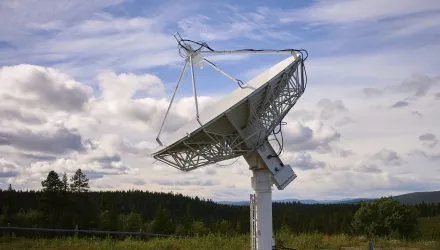International Security is America's leading peer-reviewed journal of security affairs.

This policy brief is based on "Why Nuclear Energy Programs Rarely Lead to Proliferation," which appears in the fall 2017 issue of International Security.
Bottom Lines
-
Overstated Links between Nuclear Energy and Proliferation. Contrary to many scholars’ and analysts’ claims, countries with nuclear energy programs historically have not been significantly more likely to pursue or acquire nuclear weapons.
-
Timely Intelligence and Sanctions. Although nuclear energy programs increase a state’s technical ability to develop nuclear weapons, they generate countervailing political obstacles to proliferation. Proliferators with nuclear energy programs are more vulnerable to intelligence-gathering efforts and nonproliferation pressure and encounter higher costs from nonproliferation sanctions, which may cripple their energy programs.
-
Decline of the U.S. Nuclear Industry and the Risk to Nonproliferation. The ongoing decline of the U.S. nuclear industry threatens to erode political obstacles to proliferation, as the diminished U.S. role in the nuclear marketplace means that the United States is less able to use peaceful nuclear trade to promote and enforce nonproliferation norms.
Longstanding conventional wisdom holds that nuclear energy programs increase the odds of nuclear weapons proliferation by providing states with the means, motive, or political cover needed to acquire the bomb. This notion animates contemporary debates over the growth of nuclear energy programs in the Middle East, which many observers worry is a prelude to a nuclear arms race.
Overstated Links between Nuclear Energy and Proliferation
The historical record does not support the idea that nuclear energy programs increase the odds of proliferation. Out of more than fifteen countries that have sought nuclear weapons since the world’s first nuclear power reactor came online in the mid-1950s, only five had ongoing nuclear energy programs prior to seeking nuclear weapons—Argentina, Brazil, India, Iran, and Pakistan. The other ten either pursued nuclear weapons via largely covert programs or started nuclear energy programs after they had already begun seeking the bomb. Only one country—Argentina—had an operational power reactor prior to pursuing nuclear weapons. Moreover, countries pursuing nuclear weapons under the cover of nuclear energy programs have not been significantly more likely to acquire the bomb than those that followed a covert approach.
Timely Intelligence and Sanctions
Nuclear energy programs do increase countries’ technical ability to develop nuclear weapons, including by providing them with a source of plutonium and improving their general nuclear know-how. This technical advantage is counterbalanced, however, by the political obstacles to proliferation that nuclear energy programs generate. Specifically, nuclear energy programs facilitate U.S. and international nonproliferation intelligence efforts and make potential proliferators more vulnerable to nonproliferation sanctions.
Countries that seek to proliferate under the cover of a nuclear energy program are more vulnerable to U.S. and international intelligence efforts for at least four reasons. First, nuclear energy programs are public endeavors that are likely to invite scrutiny from foreign intelligence agencies, particularly if the country developing nuclear energy is in an unstable security environment, lacks a compelling economic justification for a nuclear energy program, or announces that it intends to build enrichment or reprocessing facilities. Second, nuclear energy programs involve regular acquisitions of material and technology from foreign firms, providing more opportunities for intelligence agencies to collect information on the program and allowing the program to be infiltrated. Third, such programs offer clear targets—for example, reactors, research centers, and nuclear scientists—on which intelligence agencies can focus their efforts. Fourth, they generally come with International Atomic Energy Agency safeguards on relevant facilities, either because of the recipient country’s membership in the Nonproliferation Treaty (NPT) or because of supplier requirements.
Declassified U.S. intelligence assessments show that proliferators with nuclear energy programs are detected in a more timely fashion compared to proliferators without such programs. Specifically, for the reasons stated above, the United States has been less likely to underestimate the progress of proliferators using an energy program as a cover. Moreover, these proliferators have been more likely to face U.S. nonproliferation sanctions than countries that pursued nuclear weapons without energy programs, suggesting that timely intelligence translates into international pressure.
States with nuclear energy programs also face higher costs than those without them from nonproliferation sanctions, which generally involve a cutoff of nuclear supplies. For countries that rely on nuclear energy to fuel their economies, a cutoff can be prohibitively expensive. Nuclear energy programs are especially vulnerable to sanctions because the nuclear industry is highly regulated and globalized. A relatively small number of countries build power reactors abroad, and all are members of the Nuclear Suppliers Group (NSG), which requires exporters to secure safeguards and other nonproliferation commitments. Moreover, light water power reactors—by far the most common type of reactor in use—rely on enriched uranium fuel, which is usually imported from one of a few major suppliers. Thus, although proliferators may hope that a nuclear energy program will aid their acquisition of nuclear weapons, they may discover instead that it renders them extremely vulnerable to international nonproliferation pressures.
The United States, in particular, has long used its nuclear supply relationships as a source of leverage for enforcing nonproliferation. The threat of damaging U.S. sanctions against their nuclear energy programs is an important reason why countries such as Japan, South Korea, Sweden, and Taiwan do not have nuclear weapons today, despite facing serious security threats.
Decline of U.S. Nuclear Industry Poses Risks to Nonproliferation
Despite its past dominance, the United States has lost significant ground in the international nuclear export market in recent years. U.S. firms are building only a handful of the more than fifty power reactors currently under construction. At the same time, the role of nuclear power domestically in the United States has stagnated, and U.S. production of enriched uranium fuel has decreased, further reducing the United States’ ability to export. As the U.S. nuclear export industry has declined, Russia has assumed a dominant role in the market, with South Korea and France also playing significant roles. Both China and Japan aspire to become major nuclear exporters. These trends raise the question of whether the relationship between nuclear energy programs and proliferation will change in a world where the United States is a marginal supplier.
On the positive side, all the key suppliers noted above are members of the NPT and NSG. These institutions were founded partly to address the risk of a competitive nuclear marketplace leading to proliferation, and substantial evidence suggests success on this score. Nevertheless, the increasing role that specific countries—in particular, China and Russia—will likely play in the nuclear marketplace may be grounds for concern.
Although China has increasingly accepted international nonproliferation principles, it has displayed troubling behavior as a supplier historically, including exporting enrichment or reprocessing technology to Algeria, Iran, and Pakistan and providing a few bombs’ worth of highly enriched uranium to Pakistan in the 1980s. Moreover, China still engages in nuclear trade with Pakistan despite the latter’s status as a nonproliferation pariah. Russia has a strong nonproliferation track record overall, but growing tensions with the United States have led Moscow to scale back some of its nonproliferation advocacy. This trend could worsen if U.S.-Russian relations continue to deteriorate.
The United States may be able to substitute other forms of economic or political leverage to make up for its declining role in the nuclear marketplace, but this is by no means guaranteed. The United States therefore has a strong interest in seeking to revive its nuclear export industry to hedge against the possibility that its other sources of leverage fail and non-U.S. suppliers undercut nonproliferation standards. To regain a foothold in the export market, the United States should also refrain from demanding the so-called “gold standard”—which requires the recipient to formally foreswear enrichment or reprocessing—in its nuclear cooperation agreements with foreign countries. The United States has other tools, including diplomacy and sanctions, that it can use to prevent the acquisition of enrichment or reprocessing technology after nuclear cooperation begins. Demanding the “gold standard” has the effect of further reducing U.S. market share, as recipient states can simply turn to other suppliers, such as Russia, that do not require such restrictions.
Conclusion
A careful review of the historical evidence suggests that the links between nuclear energy and nuclear weapons proliferation are overstated. Although nuclear energy programs make it technically easier for states to develop nuclear weapons, they make it substantially more difficult politically, as proliferators with energy programs are more vulnerable to intelligence collection efforts and nonproliferation pressures. This suggests that the spread of nuclear energy can be managed and will not inevitably lead to greater proliferation of nuclear weapons. Nevertheless, because these political obstacles are largely the result of effective policy countermeasures, officials in the United States and elsewhere should remain vigilant and committed to nonproliferation if they hope for these trends to persist.
Related Resources
Matthew Fuhrmann, Atomic Assistance: How “Atoms for Peace” Programs Cause Atomic Insecurity (Ithaca, N.Y.: Cornell University Press, 2012).
Francis J. Gavin, “Strategies of Inhibition: U.S. Grand Strategy, the Nuclear Revolution, and Nonproliferation,” International Security, Vol. 40, No. 1 (Summer 2015), pp. 9–46, doi:10.1162/ISEC_a_00205.
Nicholas L. Miller, “The Secret Success of Nonproliferation Sanctions,” International Organization, Vol. 68, No. 4 (Fall 2014), pp. 913–944, doi:10.1017/S0020818314000216.
Nicholas L. Miller is Assistant Professor in the Department of Government at Dartmouth College.
International Security is America’s leading peer-reviewed journal of security affairs. It provides sophisticated analyses of contemporary, theoretical, and historical security issues.
International Security is edited at Harvard Kennedy School’s Belfer Center for Science and International Affairs and is published by The MIT Press.
For more information about this publication, please contact the International Security publications coordinator at 617-495-1914.
Statements and views expressed in this policy brief are solely those of the author and do not imply endorsement by Harvard University, the Harvard Kennedy School, or the Belfer Center for Science and International Affairs.
Nicholas L. Miller, "Nuclear Energy and the Spread of Nuclear Weapons: How Worried Should We Be?" (Cambridge, Mass.: Belfer Center for Science and International Affairs, John F. Kennedy School of Government, Harvard University, November 2017).





